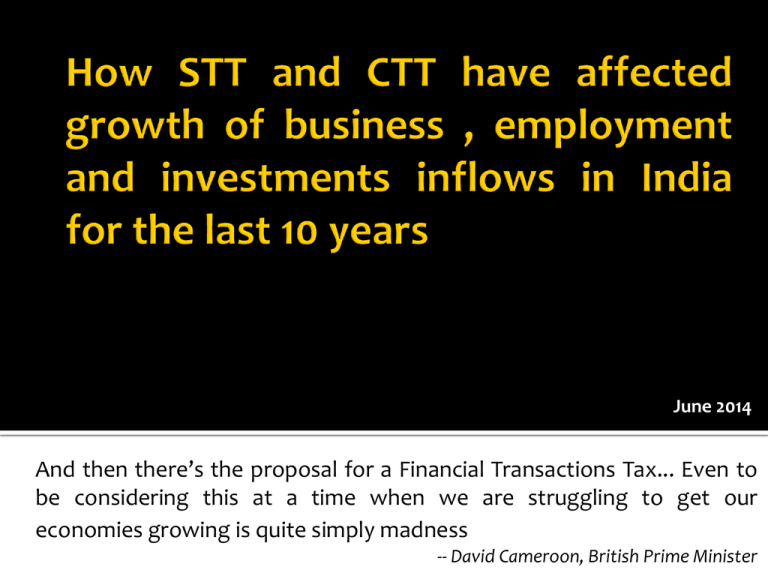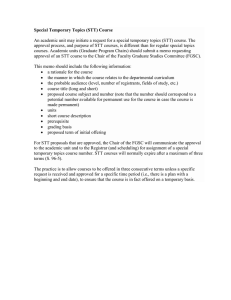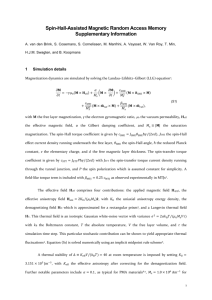Indian Financial Markets Scenario
advertisement

June 2014 And then there’s the proposal for a Financial Transactions Tax... Even to be considering this at a time when we are struggling to get our economies growing is quite simply madness -- David Cameroon, British Prime Minister Average Daily Volumes across the Globe in May 2014: Country MCX, India Shanghai, China CME, USA / LME, UK Gold (Rs. Crore) Copper (Rs. Crore) 3,975 1,075 37,415 116,500 128,740 148,200 China is 9 times India and U.S. is 32 times India We aspire to be among the world’s leading industrialized nations but the volumes of Copper, the flagship industrial metal, in China is 108 times India & in London 137 times India How much Gold can you buy at best available Sell Price & Vice Versa without a change in Price? SHFE China CME U.S. Country MCX India You Can Sell You Can Buy Kgs Rs. Crore Kgs Rs. Crore China 155 40 391 99 U.S. 106 25 115 28 4 1 2 0.5 India At a Single Price, you can buy just Rs. 0.5Cr worth in India while you can buy Rs. 99 Cr in China & Rs. 28 Cr in U.S. Cost of Hedging 1 Cr. Gold Future Metal Future Gold Future Any Comm. Future Head CME LME China India Exchange Fees 150 350 400 210 GST/ S. Tax 0 0 0 26 Stamp Duty 0 0 0 200 CTT 0 0 0 1000 150 350 400 1436 Cost per Cr. Company Commodity Hindalco Aluminium Hindalco Copper Sterlite Copper 90725 MT Buy & 90425 MT sell actual (Rs 8300 cr ) Sterlite Gold 62478 ounces buy & 143779 sell actual (Rs 1580 cr) Sterlite Silver 603152 ounces buy & 2295815 sell actual (Rs 343 cr) BPCL Crude Oil Rs 79612 cr import; hedge not disclosed HPCL Crude Oil Rs 55934 cr import; hedge not disclosed IOC Crude Oil Rs 184558 cr import; hedge not disclosed Cost of Hedging is significantly high in India as compared to globally Large Corporate have massive hedging requirements. Most Large Corporates are hedging more than 90% of their needs in International Markets If large Companies can find hedging attractive in India, it will save millions of $ in foreign Exchange, increase employment in Indian financial sector, make our market vibrant and increase Government service tax collections. Vicious circle: CTT is reducing liquidity & increasing hedging costs and hence these companies are finding India too expensive & shallow to hedge. Non participation by these companies is further reducing the liquidity. Hedge Activity abroad 353350 MT actual hedged yr end (Rs. 4452 cr approx) 72400 MT actual hedged yr end (Rs 3342 cr approx) If we can abolish CTT & make our exchanges attractive to these companies: A huge amount of margin money in Foreign exchange can continue to be in India and benefit the system Liquidity in our markets will deepen and allow other industries like extrusions , plastics and so many others to hedge their risks Huge saving of Millions of Dollars paid out by these companies in foreign exchange towards brokerage , commission , exchange charges Increase in employment in Financial sector in India Increase in service tax and other revenues to Govt. Rank Exchange Notional Value(bn USD) 1 USA 36000 2 CFFEX 12034 3 EUREX( euro stoxx 50) 9692 4 EUREX(DAX futures) 8223 5 Korea Exchange 7087 6 NYSE LIFFE(FTSE 100) 2481 7 JPX (OSAKA) NIKKEI FUTURES 2228 8 NYSE LIFFE(CAC 40) 1637 9 JPX( OSAKA) 1488 10 TAIFEX 1246 11 MOSCOW EXCHANGE(RTS INDEX FUTURES) 947 12 NYSE LIFFE(FUTURE AEX INDEX) 866 13 BM&FBOVESPA(BOVESPA INDEX FUTURE) 681 14 EUREX( SMI FUTURES) 603 15 NYSE LIFFE(FTSE 100) 495 16 NSE INDIA(CNX S&P NIFTY) 399 Source: WFE/IOMA Derivatives Market Survey 2012 India Benchmark Index ( Nifty Futures) investments lowest in the World . Investors who want exposure in any country can buy a Benchmark Index Future. It will give them exposure to the Index without the expense of purchasing all the underlying assets on the Benchmark Index. India might be in one of the top derivatives exchanges but only in number of contracts. In notional value, we are one of the lowest in G20 and lowest in BRIC Countries USA leads the table with 36000 bn USD, about 90 times that of India. China is 30 times To measure the health of a market, most economists recommend: Turnover Ratio for a year Country = Total Trading value of all shares in that year Average of (Opening Market Cap and Closing Market Cap) 2003 2012 % Growth H. K. 48 123 156 Brazil 34 68 101 China 83 164 97 Russia 46 88 92 S. Africa 45 55 21 Japan 88 100 13 U.S.A. 123 125 2 France 95 66 -30 139 55 -61 India Source: The World Bank, http:// data.worldbank.org/indicator/CM.MKT.TRNR Ratio is used by World Bank for comparing countries with varied GDPs and Market Caps Data for 9 years starting 2003, a year before STT Brazil, Russia, China have grown 92% to 101% over 9 years while India has shown 61% degrowth In developed countries, France which introduced FTT is showing degrowth as compared to a stable U.S. and Japan At 2012 end, India’s turnover ratio was 55 compared to average of 94 for the sample with China’s ratio being 164 Low Turnover Ratio is affecting liquidity and investment flows in Indian industry Year Value (in Crore) %age Growth 2004 93432 2005 623575 2006 2025665 2007 2729821 34.76 2008 4284653 56.96 2009 5956656 39.02 2010 8696870 46.00 2011 14932852 71.70 2012 14890596 Jan to Jun 13 Jul to Dec 13 Jan to 6th Jun 14 % change in Impact cost from pre CTT to post CTT Gold Copper Crude Oil 10.30 am 16% 28% 33% 12.30 pm 123% - -1% 2.30 pm -49% 16% 62% 4.30 pm 65% -25% 109% 6.30 pm 37% 208% -59% -0.28 8.30 pm 80% 120% 159% 7356793 -1.19 10.30 pm 34% 87% 147% 3376412 -54.10 2344004 -68.14 Average Increase in Impact Cost 34% 55% 49% The volumes have crashed by 60% post CTT regime * Volumes above are those on MCX Source: Working paper on Impact of Transaction Taxes on Commodity Derivatives Trading in India by ICRIER STT makes our trading cost 5 times the cost of trading in Singapore Head Singapore 35% India 190 30% Exchange Fees 231 GST/ S. Tax 16 23 Stamp Duty 0 200 STT 0 1000 10% SEBI TOT 0 20 5% 247 1433 0% Cost per Cr. Result: Singapore NIFTY Volumes as a %of total NIFTY has breached 30%, directly affecting growth of our financial markets and employment 25% 20% 15% 2006 2007 2008 2009 Source: Bloomberg Volumes of SGX and NSE are normalized to equivalent quantity, Currency factor has been taken at 50 2010 2011 2012 2013 2014Q1 SGX volume as % of total volume Because Derivatives are a form of insurance or risk management, the cost of trading in them has to be low or investors will not find it economically sound to purchase such "insurance" for their positions It is shocking that open interest on NIFTY Futures worth Rs. 32352 Cr sits on foreign soil & is higher than that on NSE with Singapore having 60% market share If this trade is retained in India: The margin Money of Rs. 2543 Cr will be in India and benefit the system These volumes will be great add to the market depth and reduce impact cost It will enhance employment in financial sector Increased Service Tax Collection on brokerage coming to Indian Firms instead of foreign counterparts 80% 70% 60% 50% 40% 30% 20% 10% 0% 2006 2007 2008 2009 2010 2011 2012 2013 SGX OI as % of total OI Explicit Cost of Delivery Trades in Cash Market Nature of Cost Payee Brokerage Broker TOT Cost / Cr. (Rs) Cost Breakup Weight (%) Govt. Broker 5000 29 Exchange 325 2 Exchange Service Tax Govt. 658 4 SEBI Stamp Duty Govt. 1000 6 STT Govt. 10000 59 SEBI TOT SEBI 20 0 Total Cost 17003 100 Add: Impact Cost 6000 Total Cost 23003 •Out of total explicit cost 68 % goes to the government. How can any Industry survive after paying 68% to the government? •STT Constitutes 58 % of total explicit cost •Broker only get 29 % of the explicit Cost To buy securities worth Rs 1 Cr, buyer incurs Rs 23000 which is very high STT first directly increases cost itself and then increases cost indirectly as the impact cost increases dramatically. Live Mint: 22nd January 2014 15,000 sub-brokers have gone out of business since April 2013: SEBI. ▪ 30,000 sub-brokers have closed down since April 2011 ▪ Reason mainly due to dwindling interest from retail investors and tighter regulations ▪ Brokers also out of business, number fell by 600, highest in 3 fiscal years Financial Express: 09th July 2013 Stock Market: 14,000 sub-brokers shut shop ▪ Worst time for a sub-broker ▪ Cash Market volumes plummeting to record four year low ▪ Declining Retail Interest ▪ Surviving business has increasingly difficult Mutual Funds saw net outflow in Equity Schemes & cannot fund long term equity needs of midsize companies 50,000 65 46933 60 40,000 55 30,000 50 20,000 45 10,000 4024 2149 121 0 40 Retail Active Investor Participation directly into markets is also down hugely. FII Participation is most desired but not their domination in absence of a counter force 62.97 55.63 54.86 49.17 40.47 38.85 35 -10,000 30 -13138 -20,000 2007-08 2008-09 2009-10 2010-11 2011-12 MF Equity Mobilization (in Crore Rs.) Source: SEBI Handbook 25 2007-08 2008-09 2009-10 2010-11 2011-12 2012-13 Retail Participation in Stock Market (%age of Total) Active retail investors disallowed 88E tax rebate, face double taxation & have stopped providing liquidity Rules do not allow Institutions to invest in Low Turnover and High Impact Cost Companies Investor putting idle money into non productive Gold GROWTH Against 42595 Cr raised in 2007–08. Average of next 4 years only, Rs. 25963 Crore 2007-08 42595 2008-09 2082 2009-10 35559 2011-12 41515 0 10,000 20,000 30,000 40,000 IPO Mobilization (in Rs. Crore) Source: SEBI Handbook New SME Market not even properly born NSE SME Market inaugurated in Sep 2012, in 2years: • Only 5 Cos Listed • Raised only 86 Crores • Total Turnover only 40 Crores Issue Size Rs Cr Turnover Thejo Engineering 19 1 Veto Switchgears 25 35 Opal Luxury Time 13 1 MITCON Consultancy 25 1 4 3 86 40 Company 24696 2010-11 50,000 Sanco Industries Total Average number of Shares per day No. of Cos < 10000 337 > 10000 & < 20000 139 > 20000 & <50000 201 > 50000 & <100000 145 > 100000 & < 200000 146 > 200000 523 Total No. of Cos 1491 More than 65% of Companies trade less than 2 Lakh shares a day 476 cos ( 31% ) trade less than 20,000 !! As a result, Strong Fundamentals of companies Ignored due to low liquidity as Investors avoid stocks with no exit, i.e. low liquidity, high impact cost caused by STT Data is for 15th May 2014 to 14th June 2014 when the Index and Market Cap was the highest Top 6% of the total listed companies dominate 82% of the turnover Earlier farmers, just after harvest, were selling their crop to the processors at distress prices who were making super normal profits Cynics say that farmers do not trade in India. But prices disseminated by NCDEX, FMC and MCX help the farmers know the correct price and ensure that processors pay them the right price Also, efforts by NCDEX and MCX have ensured that an ecosystem of huge no. of modern warehouses along with laboratories and assayers. This safe system has encouraged modern financial players to deploy funds in cash and carry arbitrage with a return expectation of 15%. This far lower than the traditional moneylenders who used to rip off farmers , growers. Financiers are storing in warehouses and are selling in the market in a staggered manner according to demand instead of all at harvest time Jeera Production Castorseed Oil Export 2006-07 185000 CASTOR SEED MEALS EXPORT 202175 2007-08 175000 339475 2008-09 152000 305000 203915 2009-10 176000 340000 240466 2010-11 190000 343254 209036 2011-12 218000 404489 341308 2012-13 275000 430752 383392 2013-14 375000 Earlier exporters could not take firm export orders as they were not confident of getting confirmed supplies at a fixed price. Now, exporters are buying far month futures and are able to quote firm prices and deliver schedules to overseas buyers . All this has ensured that Castor Seed exports from India have greatly grown in last 5 years along with the exchange ecosystem. Figures in Crores F.Y. CM TO CM-NON ND STT TO STT No of Scripts Traded Index and Stock FUTURE Market Capitalisation TO STT Index and Stock Options TO STT 2004-05 11,91,364 316 7,38,646 56 870 15,85,585 22,56,203 127 2,90,779 17 2005-06 18,89,667 1,738 11,71,594 127 956 28,13,201 43,05,452 573 5,18,722 69 2006-07 22,44,170 2,814 13,91,385 362 1,191 33,67,350 63,70,541 1,185 9,85,701 168 2007-08 40,29,072 5,178 24,98,025 626 1,264 48,58,122 113,69,230 1,974 17,21,247 293 2008-09 29,82,904 3,610 18,49,400 502 1,327 28,96,194 70,49,753 1,201 39,60,729 131 2009-10 44,49,216 4,871 27,58,514 758 1,968 60,09,173 91,29,635 1,552 85,34,029 121 2010-11 38,77,777 4,653 24,04,222 601 1,607 67,02,616 98,52,510 1,675 193,95,709 136 2011-12 29,89,141 3,587 18,53,267 463 1,807 60,96,518 76,52,668 1,301 236,97,062 166 2012-13 28,73,436 2,758 17,81,530 445 1,683 62,39,035 67,51,003 1,148 247,82,001 173 2013-14 29,88,601 2,869 18,52,933 463 1,768 65,17,421 80,34,577 803 301,91,011 211 Data Source Nse 2011-12 to 2013-14 are Approx figures Post u/s 88e removal from 2009 onwards Turnover has fallen continuously across all segments though Market Capitalization has increased. When STT was bought in, official reason was in lieu of it, Capital Gain Tax benefit is being given. But no such benefit was given in lieu of CTT and hence there is no rationale for the birth of CTT. People are paying indirect taxes: excise on Manufacturing, service tax on Services, and VAT on sale. And Direct Income Tax on Profits. Then, what is the nomenclature of CTT ? Thus, CTT is an entry level regressive tax and an albatross around the neck of market liquidity. It is a mindless collection of revenue lacking any basis. STT was brought in with NIL Long Term Capital Gains Tax. However, people in Trade and Commerce, who are assessed under “Business Income”, in any case, pay full 30% Tax and Surcharge both for Equities and Commodities. They are not eligible for any benefits on Capital Gains So paying CTT & STT and direct Income Tax at 30% leads to effective taxation rates upwards of 80% Section 88E withdrawal from April 2008 led to huge fall in Market Volumes and Government collection of STT Till 31st March 2008, STT was treated as tax rebate under section 88E and the market was somehow able to cushion the impact of STT slightly. However, the withdrawal of 88E and consequent double taxation completely broke the back of the market and huge fall in volume. STT Collection on delivery dropped from 5178 Cr in 2007-08 to 2869 Cr in 2013-14 Worldwide in any Business there are 2 types Taxes:- Manufacturing(Vat, Excise,etc) or Service Tax. Derivative trading doesn’t come under Manufacturing and our Sector pays service Tax. STT is nor a manufacturing tax or service tax so it should be removed. Studies Sample Type of reform Measure of Liquidity Result for liquidity Hu (1998) H.-K.,Japan, Korea,1977-93 STT Turnover Inconclusive Baltagi et al. (2006) China 1997 STT Volume Negative Chou & Wang (2006) Taiwan 1999-2001 STT Volume,bid-ask Negative Liu (2007) Japan 1989 STT Autocorrelation Negative Foucault et al.(2011) France 1998 to 2002 Cost of forward Auto covariance, Amihud Negative Pomeranets & Weaver 2012 U.S. 1932 to 81 STT Holden spread Negative Among major nations across the world, there is no FTT/ STT except India and Taiwan Country Futures Options Country Futures Options Australia na na Russia na na Brazil na na South Africa na na Canada na na South Korea na na China na na Hong Kong na na France na Na Singapore na na Germany na na Switzerland na na Japan na na Taiwan 6bps on Index 10-60 bps on premiums India 0.017% of delivery Price 0.017% on premium, 0.125% on strike Welfare of India should be Government’s prime objective Its decisions should not be influenced by revenue considerations alone It needs to be a balance between market growth and revenue collection Continue with STT/CTT Collect Revenue of Rs 4000 Cr. Boost Growth 1. Increase market liquidity 2. Bring back exported markets 3. Kick start fundraising by Industry 4. Increase Employment People say Govt. will never abolish STT & CTT as it yields Rs 4000 Cr. At National level, Rs 4000 Cr is not big. It is less than what TCS earns in 1 qtr It is too small a price to pay for the prosperity of nation The Government should abolish CTT & STT and treat this Rs. 4000Cr as a historic national investment to take our markets to a much higher level. Like any good investment, this investment will yield huge returns over time. The removal of these regressive taxes will hugely reduce the impact cost in markets and greatly increase the liquidity. There will be huge gains resulting from deepening of National Markets & benefits to entire ecosystem due to linkages with the economy e.g. Fund raising by industry ; Channelizing of household savings in productive assets Disinvestment by Govt. Employment Generation Taxes on profits of individuals and corporations due to buoyant economic conditions Huge Increase in Service Tax because of Increase in Brokerage & Turnover. Instrument Current Rates Request Rationale Equity Futures Rs 1000/Cr. on sell Abolish or Rs50/Cr. for audit trail No tax on hedge instruments anywhere in the world; Equity Options Rs 1700/Cr. on sale on premium Abolish or Rs50/Cr. for audit trail No tax on hedge instruments anywhere in the world; Revenue Loss (Cr.) 800 200 Rs 12500/Cr. on Equity Options underlying value to Exercise buyer of option Abolish or Rs5000/Cr. on underlying value to buyer of option To Save tax partly , people square up open interest Equity Cash Delivery Rs 10000/Cr. on buy and sell Abolish; or Rs 5000/Cr. only on sell Tremendous boost needed for shallow cash market 2100 Equity Cash Non Delivery Rs 2500/Cr. only on sell Abolish or Rs50/Cr. for audit trail Enable liquidity provider to reduce impact cost by providing tight bid ask 460 Commodity Futures Rs 1000/Cr. on sell Abolish or Rs50/Cr. for audit trail No tax on hedge instruments anywhere in the world; Huge scope to build commodity eco system 600 For Indian taxpayers assessed under Business Income, paying 30% slab rates & not claiming Capital Gains, section 88 E tax rebate should be restored









